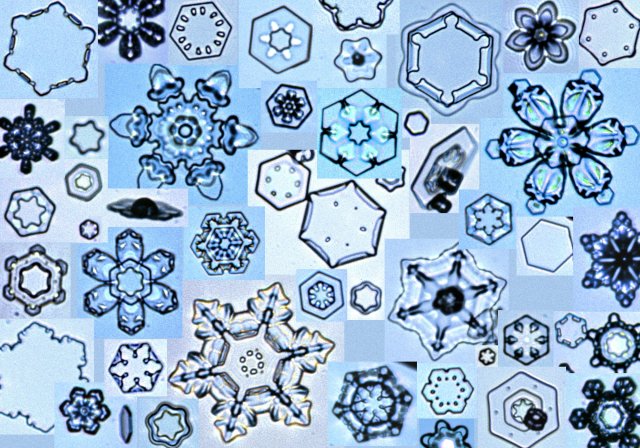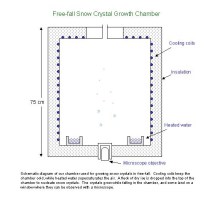 image by SnowCrystals.com
image by SnowCrystals.com
You might be surprised to learn there is a Caltech professor studying snow crystals. (Or if you've ever been to a party at Caltech, it might actually make sense.) He runs a website and owns a database of some strikingly beautiful images of snow crystals. He writes:
Snowflakes and snow crystals are made of ice, and pretty much nothing more. A snow crystal, as the name implies, is a single crystal of ice. A snowflake is a more general term; it can mean an individual snow crystal, or a few snow crystals stuck together, or large agglomerations of snow crystals that form "puff-balls" that float down from the clouds... The water molecules in an ice crystal form a hexagonal lattice... There are two hydrogens for each oxygen, so the chemical formula is H2O. The six-fold symmetry of snow crystals ultimately derives from the six-fold symmetry of the ice crystal lattice.
 snapshot of a laser cut file
snapshot of a laser cut file
You might not be surprised to learn that I have a deep fascination with walled cities or 'star forts.' This military planning science originated in the 15th and 16th century and was taken to its "logical extreme" by architects such as Vauban and Menno van Coehoorn (via Wikipedia). And if you ever see the drawings that Michaelangelo did for Florence's earthworks, they are erotic, if a little impractical. Lets learn more about these things:
The original 'Italian' fortresses were comparatively simple structures. During the seventeenth century, however, the growing power of the cannon with which they were confronted, as well as their own logic, caused them to grow and become more complicated. At first, outlying or detached structures would be built to protect the corners of the basions; next, those structures themselves would require protection, and the whole lot would have to be linked with the main fortress, at which point the process repeated itself. Thus first-class fortresses, such as those constructed by Vauban or Coehoorn around 1690, became ever larger. They acquired ravelins and redoubts, bonnetttes and lunettes, tenailles and tenaillons, counterguards and crownworks and hornworks and cuvettes and fausse brayes and scarps and cordons and banquettes and counterscarps...
-from the
Oxford History of Modern War by Charles Townshend pp. 211-212
.jpg)
In October I was in Northern Italy and visited the walled city of Palmanova with Branner fellow
Nicolette Mastrangelo. The fortress, curiously enough, is a hexagon at the center and contains nine points. The logic is that a commander at the center can view the action on the ramparts and direct the cannon reinforcements with utmost speed. Contrary to what the plan might suggest, this is not a panoptic system in the pure sense. The commander at the center can't actually see over the ramparts - to build such a tower would be to invite decapitation. However, walled cities did function to project power over a large section of territory, which is a very panoptic concept. Imagine how the function of a walled city is now accomplished by satellites and drones today, a dramatic reduction in material though certainly not in engineering effort.
 Neuf Brisach, a walled city planned by Vauban
Neuf Brisach, a walled city planned by Vauban
Tis' the season, right? Naturally, one needs Christmas ornaments... the most symmetrical walled cities could be done paper snowflake-style, but if you have access to a laser cutter in your neighborhood...


postscript
How does this Caltech professor study snow crystals? The production of snow crystals also embodies an architecture. We learn that they are grown in a convection chamber, shown schematically below.
 a convection chamber, image by SnowCrystals.com
a convection chamber, image by SnowCrystals.com (
larger)
Basically it is just a cold chamber about a meter tall, with two containers of heated water on the bottom. Convection mixes the water vapor into the cold air, creating supersaturated air for growing snowflakes. We nucleate crystals by dropping a speck of dry ice in the chamber, or by rapidly expanding some cold compressed air inside the chamber.
Can you imagine the sort of chamber that would grow walled cities? Exchange humidity for population, temperature for animosity with your neighbors, input available building materials...
Happy Holidays everyone! And email me if you want the CAD file.


 snapshot of a laser cut file
snapshot of a laser cut file.jpg)
 Neuf Brisach, a walled city planned by Vauban
Neuf Brisach, a walled city planned by Vauban



8 Comments
snowflakes are symmetrical because the water molecule is also symmetrical. so if you check out anything in nature that contains water there is inherent symmetry. just wanted to share, great post.
awesome post.
i have been to snowcrystals.com many times in the past so this was joyfully nostalgic for me. of course, my interests then were of complete geek fascination and not architectural, but i really enjoy this comparison. specifically, i find an interesting relationship between the nuclei of ice crystals (the central ingrediant that allows the process of ice nucleation to begin) and the commander in the semi-panoptic systems of the star forts. if you could grow cities in this way, you might be on to something..
happy holidays.
thanks for your sharing !!
__________________
http://www.dvdshop88.com/en/thrillers-crime-mystery-/house-m-d-seasons-1-5-dvd-boxset.html
http://www.dvdshop88.com/en/special-interests-/p90x-extreme-home-fitness-13dvd-guides-and-booklets.html
great post. and I love your blog!
I used to be interested in penrose tiling and islamic architecture. below is a famous article that details this overlap (no pun intended)
quasi-crystal
I also found it interesting that the pentagon is a geometrical shape. Do you know anything about this?
On another tangent: I once confused a pphotograph of Mecca with the Pentagon. Something about their exteriority made me mix them up.
lol at the spam. they conversate now...
there's a spam novel being written on one of my older posts:
http://www.archinect.com/schoolblog/entry.php?id=86605_0_39_0_C
man, i love me some vauban.
my dad dragged me to several of his fortifications as a kid.
the vauban ornament is actually neuf-brisach. breisach (german) is a few klicks east of neuf-brisach on the other side of the rhine.
i've been there several times. it's pretty cool - as an architect, but the city is dead.
although i must say the ornament doesn't do the topography justice. it almost might be better done with a CNC to route out the fortifications and massive walls.
i'd be really interested in the cad file as well.
Awesome rightup...I survived this year, actually I lived this year. After looking back at photos and past blogs I’ve written in various forums, it has been an eventful year. Thesis has been a rollercoaster of a ride.
used rv in California.
Block this user
Are you sure you want to block this user and hide all related comments throughout the site?
Archinect
This is your first comment on Archinect. Your comment will be visible once approved.